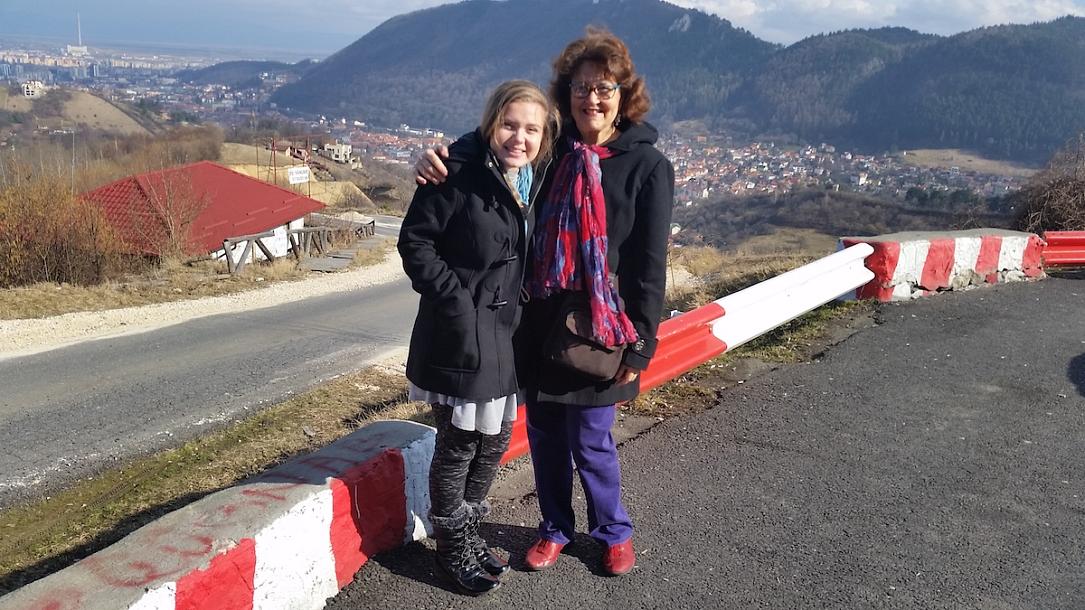My Romania Story: Luisa Girlando (US) - Romania has everything: beaches, mountains, beautiful churches and castles



Luisa Girlando, 71, first visited Romania in 1978 with a group of folk dancers. She fell in love with the country and, once back in the U.S., she decided to put her Master's Studies on pause and study the Romanian language. Thus, she returned to Romania the following summer to learn the language, culture, and literature.
Fast forward to 2012, Luisa Girlando came once again to Romania, this time as a volunteer with the Global Volunteers program in Barlad. She worked in a children's orphanage and got to discover the country even more. "Our Romanian Program Manager was also Vice-Principal of a high school, and we often met with the students. She asked me to recite "La Steaua" by Mihai Eminescu, which I still remembered after 33 years," she said.
She continued to come to the orphanage every year until 2018. And last year, she planed a personal trip to Romania, but the pandemic hit and forced her to cancel the vacation.
While in Romania, Luisa Girlando also traveled around the country to Moldavia, Wallachia, and Transylvania. She says the countryside and the mountain road Transfagarasan are "breathtaking," "the textiles and folk costumes are lovely," and the food is definitely worth a try.
"Romania has everything - beaches, mountains, ski resorts, museums, beautiful churches, castles and palaces," Luisa Girlando told Romania-insider.com.
What is your name and how old are you?
Luisa Girlando and I am 71 years old.
What is your nationality and where do you live now?
I am American, and I live in Annapolis, MD, in the U.S.A. about 26 miles from Washington D.C.
What is your connection to Romania?
When I was 22 years old, I joined a Balkan Folk Dance troup in Baltimore, MD, at Johns Hopkins University. We danced to music from Romania, Bulgaria, Hungary, Serbia, Croatia.
I fell in love with all of them, but my favorite was the music and dancing from Romania. My first visit to Romania was in 1978 with a group of folk dancers. We were on a two-week tour of Romania to learn new folk dances from folk dance groups in Bucharest, Brasov, Sibiu, and the Danube Delta. I fell in love with the country. When I returned home, I interrupted my Master's Studies to study the Romanian language. My teacher urged me to apply for a fellowship. I was lucky enough to return the following summer in 1979 and study the Romanian language, culture, and literature with the University of Bucharest at the summer school in Brasov. I continued to dance with the group well into my 60's and even taught Folk dancing in Annapolis, MD.
Is Romania an important part of your life and why?
After many years I returned to Romania in 2012. I volunteered with the Global Volunteers program in Barlad. We volunteers worked in a children's orphanage and helped the nurses and aides who worked there. I was still able to speak very simple Romanian, and it was so much fun for me to play and read and speak with the children in Romanian. I could also communicate with the employees. Our Romanian Program Manager was also Vice-Principal of a high school, and we often met with the students. She asked me to recite "La Steaua" by Mihai Eminescu, which I still remembered after 33 years. I returned to the orphanage in 2015, 2016, 2017, and 2018. The program was discontinued in 2019, and a planned personal trip in 2020 was canceled because of COVID.
What are the things you like about Romania and why?
I was able to travel around Romania to Moldavia, Wallachia, and Transylvania. The countryside is breathtaking but especially the Transfagarasan. I love the folk music, dancing, and the culture. The textiles and folk costumes are lovely. And how can I forget the food - mici, sarmale, mamaliga, and papanasi.
What don't you like about Romania and why?
I noticed that people don't openly smile at strangers and are not especially friendly. However, once I spoke to people in Romanian, all doors were opened. The people were especially friendly and generous to me.
If you had to advertise for Romania as a country, what would be the top things you would mention to promote it?
Romania has everything - beaches, mountains, ski resorts, museums, beautiful churches, castles and palaces. The painted monasteries in Moldavia are breathtaking. The architecture of the country houses is lovely. I love the painted details and the architectural detail. It is still unspoiled and American tourists have not yet discovered the country.
What are your favorite places in Romania and why?
I love Transylvania, especially the cities of Brasov, Sibiu, and Sibiel. Bucharest has changed dramatically from 1979 to the present. It is a cosmopolitan city, and the architecture is gorgeous. Many of the old churches in the Old Town have been restored to their 16th century splendor. The Old Town has cobblestone streets and outdoor cafes.
And the parks - Cismigiu, Herastrau, and Parcul Unirii, to name a few - are welcome refuges in this large city. I spent the weekend just walking through Bucharest.
Anything else to share with us, that was not covered in the questions above?
In 2016 I brought my 16-year-old granddaughter with me to volunteer in Barlad. She loved the children and really enjoyed meeting the teenagers from the high school. We both were so impressed at how well the teens spoke English and how aware they were of American politics.
newsroom@romania-insider.com
(Photo source: courtesy of Luisa Girlando)